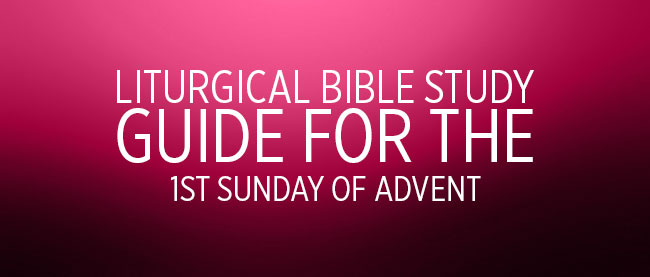Introduction
There is evidence from the mid-4th century on concerning some period of preparation for the Christmas-Epiphany celebration. Length and emphasis varied from place to place. Some regions kept a relatively long Advent (from St. Martin’s feast – November 11); others, a rather brief one. In Rome the season evolved to a four-week preparation whose focus was on the joyful celebration of the Lord’s Incarnation. In Gaul there was a longer, heavily penitential season emphasizing the Lord’s glorious advent at the end of time as Lord of history and judge of the universe. Roman practice from the 12th century, codified by the Council of Trent and enhanced by the greatly enriched lectionary of Vatican Council II, combines these different emphases. The violet vestments (with rose as an option on the 3rd Sunday) and the preaching of John the Baptist bespeak the penitential aspect which invites the people to reform. The Gloria is omitted, as during Lent, but for a somewhat different reason, as the official commentary on the revised Calendar notes: “So that on Christmas night the song of the angels may ring out anew in all its freshness.” On the other hand, there is a clear note of joyful expectation: The Alleluia is retained before the Gospel. There has been no mandatory Advent fast since the 1917 Code of Canon Law. The Ambrosian Rite in use throughout the area around Milan, Italy still observes a longer (6-week) Advent while the Eastern Rites in general observe a shorter “pre-feast” period before Christmas.
Advent is a time for looking both backward and forward. We look backward as we prepare to celebrate the historical birth of Jesus of Nazareth at Christmas. Before that birth people longed for the Messiah who would restore Israel to her former power. We identify with that ancient longing for restoration as we await Christ’s coming more fully into our lives and also as we await His Second Coming.
With that longing for restoration in mind, we recognize in Advent a time of preparation and anticipation. What we celebrate as having happened in the past points to what we anticipate is coming again. First, we recognize that Christ is born into our lives each day as we open ourselves to His grace and love. These moments of discovering birth in Christ are times when we can stand with the shepherds and hear glad tidings proclaimed. Advent is a season that prepares us to discover new birth happening over and over again for us in and thru Christ. We celebrate those birth times at Christmas. Second, we look forward in Advent to the culmination of Christ’s kingdom, when He will return in glory to fulfill the promise of wholeness as all creation responds to His healing presence. In our acclamation during the Eucharistic Prayer, we identify with this longing when we say “Christ has died, Christ is risen, Christ will come again,” or similar words in the other acclamations. Through the Holy Spirit, this new age has already begun, and this too we celebrate.
During the first period of Advent, the readings from the prophet Isaiah continually speak of God’s visitation, consolation and redemption of His people, while the corresponding Gospel selections portray Christ as the fulfillment of the prophetic promises.
1st Reading – Isaiah 2:1-5
Isaiah, the most prolific writer of all the prophets, lived in Jerusalem and prophesied from 742 to 701 B.C. The name Isaiah means “Yahweh is salvation.” A legend in the apocryphal Martyrdom of Isaiah holds that he was martyred by being placed in a hollow log and sawn in half.
Our reading for today talks of Zion in the days to come. This vision of all nations gathering on Mount Zion is found, with few changes, in Micah 4:1-3. It is impossible to say with certainty which of the two books is the original, or whether both authors borrowed from a common source.
2nd Reading – Romans 13:11-14
Our reading today is an exhortation to the Roman Christians to realize that they are already living in the end times. The two ages have met. ANow these things happened to them as a warning, but they were written down for our instruction, upon whom the end of the ages has come.” (1 Corinthians 10:11).
Gospel – Matthew 24:37-44 5
In our gospel reading today Jesus is sharing with His disciples a teaching on the end times. He is in Jerusalem for His passion and is preparing the disciples for this event and what is to follow. The eleven verses immediately preceding our reading today help us to establish the context:
26 So if they say to you, ‘He is in the desert,’ do not go out there; if they say, ‘He is in the inner rooms,’ do not believe it. 27 For just as lightning comes from the east and is seen as far as the west, so will the coming of the Son of Man be. 28 Wherever the corpse is, there the vultures will gather. (The Messiah will not come in some distant or secret place, it will be clear as lightening to all and as clearly discerned as a carcass is to a vulture.) 29 “Immediately after the tribulation of those days, the sun will be darkened, and the moon will not give its light, and the stars will fall from the sky, and the powers of the heavens will be shaken. (This is imagery from Isaiah 13:10 and 34:4. The Temple was a microcosm of the world as the Jews knew it. When the Temple is destroyed, their world is destroyed.) 30 And then the sign of the Son of Man will appear in heaven, and all the tribes of the earth will mourn, and they will see the Son of Man coming upon the clouds of heaven (Imagery from Daniel 7:13 and Zechariah 12:12-14.) with power and great glory. 31 And he will send out his angels with a trumpet blast, and they will gather his elect from the four winds, from one end of the heavens to the other. 32 “Learn a lesson from the fig tree. When its branch becomes tender and sprouts leaves, you know that summer is near. 33 In the same way, when you see all these things, know that he is near, at the gates. 34 Amen, I say to you, this generation will not pass away until all these things have taken place. [The Temple is destroyed in A.D. 70, it is now A.D. 30/33. 40 years is a generation in Hebrew numerology. Josephus, the Jewish first century historian, described the use of the catapult in the siege of Jerusalem (A.D. 70 ) in these words Athe watchmen that sat on the towers gave them notice when the engine was let go, and the stone came from it, and cried out aloud in their own country language, “THE SON IS COMING.” (The Wars of the Jews, 5.6.3§272)]. 35 Heaven and earth will pass away, but my words will not pass away. 36 “But of that day and hour no one knows, neither the angels of heaven, nor the Son, but the Father alone.


